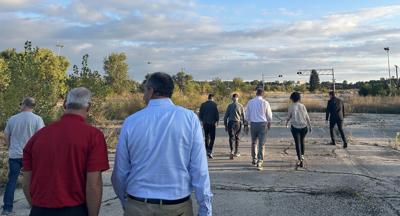JANESVILLE — The chair of the city’s GM/JATCO Redevelopment Advisory Board says he’s eager to get going with planning for the future of the former General Motors site on Janesville’s southside.
Mick Gilbertson, an architect, said he was honored to be named to the board after being involved with other local redevelopment projects in the past.
“I feel I have talents and experience to help the community and this project,” Gilbertson said.
General Motors shuttered the former Janesville GM assembly plant at the end of 2008. Demolition of buildings occurred through 2018 and 2019. This past year, the city completed a condemnation process of the GM/JATCO site and five adjacent sites, and the purchase of those sites. A third party, Commercial Development Company had owned the main GM/JATCO site since 2017, with a vision to redevelop it that never came to fruition.
In August, the city council creation of the advisory board and appointed 9 members. Two other people — Janesville Economic Development Director Jimsi Kuborn and Rock County Economic Development Director James Otterstein — were previously approved by the council to sit on the board that has a total of 11 members.
At its peak in the 1970s, the Janesville GM plant along Kellogg Avenue employed about 7,000 people. Today, the land remains capped because of soil contamination but is considered suitable for industrial redevelopment under Wisconsin Department of Natural Resources guidelines.
The GM/JATCO Redevelopment Advisory Board held its first meeting last week, taking some of that time to visit the 250-acre site that’s now a brownfield. Gilberton said it was a productive start. He said at that meeting board members received more background about the site that helped frame its responsibilities and the scope of work ahead.
Visiting the cleared site also generated excitement for the future, Gilberton said. He said while there he recalled touring the GM plant as a child and later working on projects there as an architect for Angus-Young.
“Seeing the empty, cleared expanse of the site as compared to a site that was once filled with buildings, cars and people shows the potential,” he said. “It has gone from natural land adjacent to the river before Janesville was a city, to the industrial and economic hub of the city and the region, then back to an empty site. It shows this site can be anything we want it to be.”
At this stage, Gilbertson said he is focused on helping define the project scope and goals, which will take shape through collaboration between the city, a consultant, community members and others with a stake in the outcome.
“Communication will be key,” Gilberton said. “The composition of the board is a good cross section of the community, and the city is working on ways to promote input: meetings, surveys, online presence. In selecting a consultant, communication and community engagement methods will be important.”
The board will not make direct redevelopment decisions, but will help guide the process of hiring a brownfield redevelopment consultant and shaping community engagement efforts. Gilbertson said he is most looking forward to seeing how consultants will collect and use community feedback.
As he looks ahead to what the site could be, Gilbertson said he agrees with Janesville City Manager Kevin Lahner that it should be renamed and rebranded to reflect its importance to the region and Janesville’s southside.
“For over 100 years this site was the economic and industrial center for the city of Janesville and the region,” he said. “It was at the forefront of technology and workforce for the auto manufacturing industry.”
“The decisions we make need to take this importance and meaning forward. What is at the forefront now of industry, technology and workforce and how can those become redevelopment concepts to make an impact that will carry forward for 100 years?”









